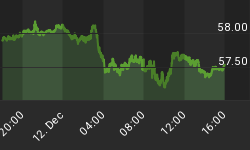Italian Elections
An extended U.S. stock market was handed some bad European news Monday. From MarketWatch:
Hopes for a clear-cut outcome in Italy's parliamentary elections on Monday gave way to fears that a strong showing by Silvio Berlusconi and his center-right allies could trigger a fresh round of political instability.
It is possible another round of elections will be required. Another round of elections means more uncertainty. Financial markets do not like uncertainty.
Last Week Charts Said "Be Careful"
While today's weakness in stocks will be attributed to the elections in Italy, stocks have been shooting up warning flares for over three weeks. One example is the ratio of small-cap growth (IWO) to Treasuries (TLT) (chart below). When the ratio rises, small-cap growth stocks are in greater demand than Treasuries (a.k.a. risk-on). Conversely, when the ratio falls, Treasuries are in greater demand than small-cap growth stocks (a.k.a. risk-off). Last time the ratio reached the top of the blue trend channel (point A), stocks corrected for several weeks (point B). The ratio is turning down again near point C. If the pattern holds, the ratio could "fill the white space" as the S&P 500 corrects further.

The February 23 video below covers numerous areas of the market that were saying "be careful" as of the close last Friday. The video covers the following ETFs: Russia (RWX) at the 4:42 mark, copper (JJC) 7:25, coal stocks (KOL) 9:26, materials (IYM) 10:06, U.S. dollar (UUP) 11:26, utilities (XLU) 13:17, shorts (RWM) 15:11, and small-cap growth (IWO) 16:17.
Unlimited QE May Not Be Unlimited
While it is unlikely the Fed's easy money policies will be altered anytime soon, the release of the last Fed minutes showed how easily markets can be spooked. It is not in the Fed's best interest to have a mass exodus from U.S. Treasuries since it puts upward pressure on interest rates. Consequently, a little jawboning to pull some of the froth out of stocks and put a bid under Treasuries is part of their game plan. The Fed will not begin unwinding their massive balance sheet in the coming months, but a little fear regarding that topic isn't such a bad thing for Mr. Bernanke and his friends.
Risk vs. Reward Matters
If you follow our work, you may get tired of the term "risk-reward". The last few trading sessions show why the term is important. After Monday's blood bath, the S&P 500 has now "taken back" 38 calendar days worth of gains. The S&P 500 closed at 1,486 on January 18. Monday's close was 1,487. We described the market's poor risk-reward profile in detail in this portion of a February 16 video.
Sequester Becoming All Too Real
Regardless of your stance on government spending and economic growth, there is no question that when the government spends less, it hurts GDP in the short-run. The impending budget cuts will have a negative impact over the coming quarters. With a massive bid under Treasuries, or TLT, Monday, the markets may be coming to grips with the short-term ramifications of the soon to be made spending cuts.
Remaining Defensive
We took profits and raised cash back on January 24 citing a poor risk-reward ratio for investors (see tweet below). The day we booked gains, the S&P 500 closed at 1,494. We have missed nothing. Monday the S&P 500 "gave back" all the gains posted over the past four weeks, closing at 1,487 (below 1/24/13 level).
















